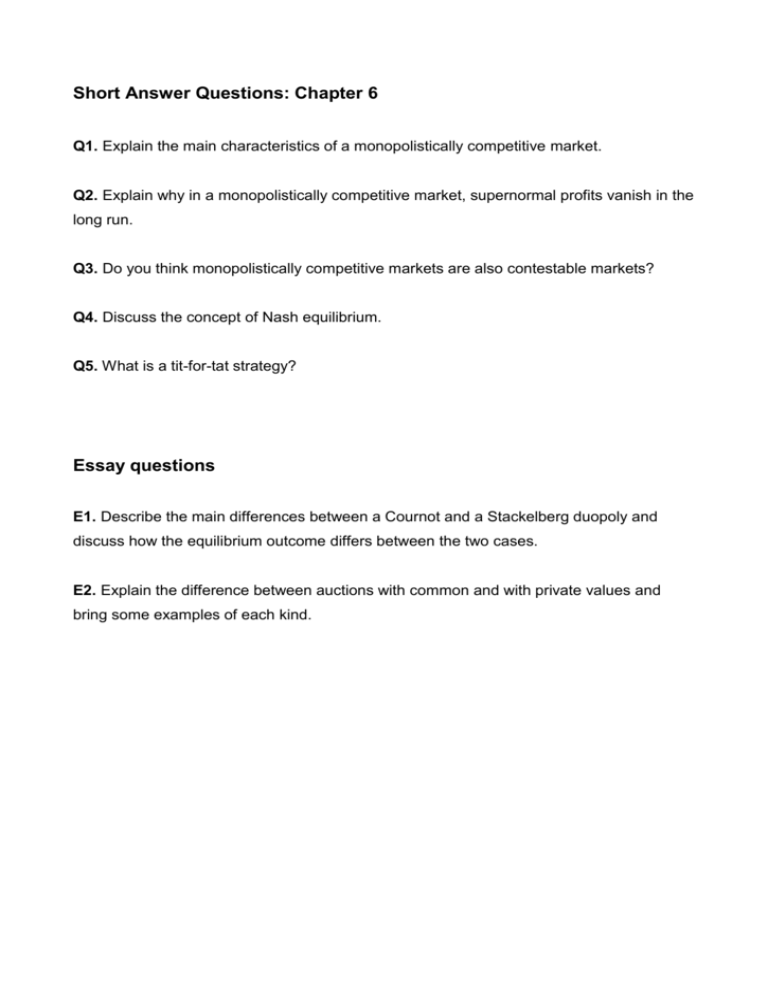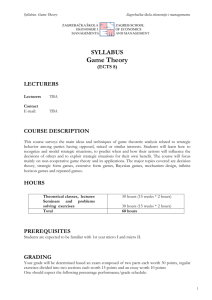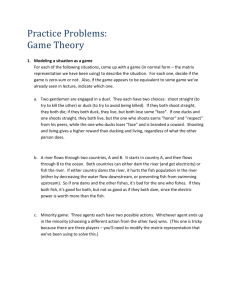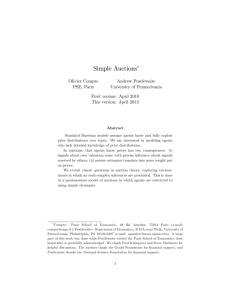Short Answers
advertisement

Short Answer Questions: Chapter 6 Q1. Explain the main characteristics of a monopolistically competitive market. Q2. Explain why in a monopolistically competitive market, supernormal profits vanish in the long run. Q3. Do you think monopolistically competitive markets are also contestable markets? Q4. Discuss the concept of Nash equilibrium. Q5. What is a tit-for-tat strategy? Essay questions E1. Describe the main differences between a Cournot and a Stackelberg duopoly and discuss how the equilibrium outcome differs between the two cases. E2. Explain the difference between auctions with common and with private values and bring some examples of each kind. ANSWERS: Short Answer Questions: Q1. Explain the main characteristics of a monopolistically competitive market. A: A monopolistically competitive market is characterised by a large number of competitors, freedom of entry and exit, no economies of scale, and heterogeneous products. Hence, it is much like perfect competition except for the existence of product differentiation. Rather, firms produce similar goods or services that are differentiated in some way. Importantly, since each supplier offers a similar but not identical product, it does not face a perfectly elastic (horizontal) demand line, as it would in perfect competition. Instead, the element of differentiation lowers the degree of substitutability between rival offerings; and results in each firm facing a downward sloping demand line. The result of this differentiation is for each small firm to have a monopoly over the differentiated version of the product or service that it provides. We, therefore, have lots of small firms offering similar but slightly different competitive offerings to consumers with varied tastes and preferences. This combination of competition and monopoly gives rise to the term monopolistic competition. Q2. Explain why in a monopolistically competitive market, supernormal profits vanish in the long run. A. If a firm is making supernormal profits, i.e. if it is selling at a unitary price above average cost, then other firms will enter the market, which unlike a monopolistic market has no barrier to entry. New entrants will shift the firm’s demand curve towards the left up to the point where it becomes tangent to the average cost curve, that is, the point where no extra profits can be made and the incentive to enter the market disappears. Q3. Do you think monopolistically competitive markets are also contestable markets? A. Yes. A contestable market is a market characterised by no sunk costs, and hence no barriers to entry or exit. The absence of barriers to entry and exit the market is also one characteristic of a monopolistically competitive market. Q4. Discuss the concept of Nash equilibrium. A. The Nash equilibrium is named after the Nobel Laureate John Nash, who proved that the optimal solution for any game must result in each player making an optimal decision given the potential response of its rival. A Nash equilibrium occurs when each player does what is best for themselves, given what their rivals may do in response. The important point to note from the Nash equilibrium is that each player considers what its rivals can do before deciding on its own strategy. Q5. What is a tit-for-tat strategy? A. A ‘tit-for-tat’ strategy is a strategy for co-operative games such that you will cooperate with your rival in the next round if they co-operated with you in the last round. If they cheated on you in the last round, you will never co-operate with them again. Such a strategy will work and lead to a co-operative Nash equilibrium if the threat to always display non-cooperative behaviour, if your rival cheated in the last round, is a credible commitment. Essay questions E1. Describe the main differences between a Cournot and a Stackelberg duopoly and discuss how the equilibrium outcome differs between the two cases. Answer guidelines. You need to highlight that a in both cases firms compete on quantity. The crucial difference is that in a Cournot duopoly, firms take their decision simultaneously while in a Stackelberg duopoly one firm acts as a leader. This firm has now a first-mover advantage, which means that it will set its profit maximising output at a higher level than in a Cournot equilibrium. E2. Explain the difference between auctions with common and with private values and bring some examples of each kind. Answer guidelines. Auctions can differ in the values held by bidders. With private values each bidder forms a private, typically subjective, view of the item for sale. Under common values, instead, an item is worth exactly the same to all bidders, but no bidder is sure what the item is truly worth. An example of the first type is with items on eBay such as a watch, a suit, an antique. Some individuals will like the item, but others will love it! Each bidder knows their own value of the item, but they do not know the valuation of the item to the other bidders. Furthermore, each bidder is unlikely to change their assessment of the item’s value, even when they become informed of other bidders’ valuations. An example of the second type is typical reallife commercial auctions: the rights to an oil field, the rights to show live football games, the rights to run a national lottery. The commercial value of the rights is common to all bidders, but what they are truly worth is presently unknown. Significantly, under common values a bidder might be willing to change their bid once they know all the bids. For example, a comparison of bids will help to inform bidders about the accuracy of their own valuation of the item for sale. If other bidders are bidding high, then a bidder might be led to believe that they have undervalued the item.










